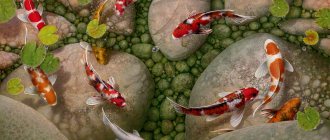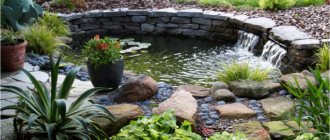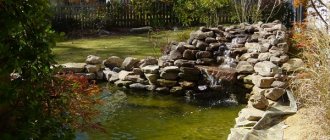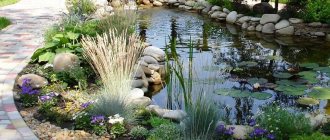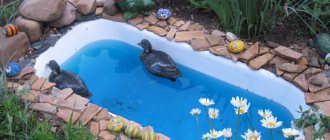Relaxing in the country is a favorite pastime for many people. The only thing that can compete with him is a trip to the shore of a reservoir. By installing an artificial pond in your dacha, you can get an excellent place to get rid of fatigue and relaxation. Moreover, building an artificial pond with your own hands will not be difficult; you just need a little perseverance and imagination.
Types of reservoirs
Depending on what functionality you plan to provide to the pond you have built, artificial reservoirs can be divided into several categories.
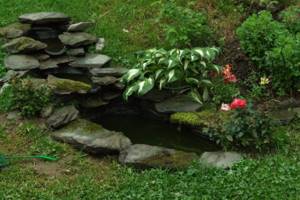
Pool
This category includes artificial reservoirs of significant size. Such a pond, built at the dacha with your own hands, as in the photo, has not only decorative properties, but also allows you to refresh yourself, or even swim, without leaving the site.

Pond with fish
A pond for breeding fish is suitable not only for fishing enthusiasts. Your family members, especially children, will enjoy spending time at the lake, watching the bright and beautiful fish.
Mini pond in the country
A small pond that is an element of the landscape composition. Performs exclusively decorative functions and does not involve placing a recreation area around it.
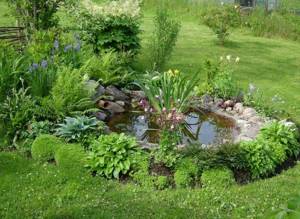
Decorative pond in the garden
A garden pond, built with your own hands, which is the central place of the recreation area. The combination of sufficient size and beautiful design will not only please the eyes, but will also give pleasant coolness on a hot day.
Style
Having decided on the functionality of the reservoir, it is worth moving on to choosing the style in which the decorative pond at the dacha will be executed. There are two main options.
- Formal (regular) pond. An artificial reservoir of strict geometric shape. Ideal if you want to emphasize the geometric shapes of a building or the site itself. Creates a sense of order and looks appropriate next to geometrically correct flower beds, lawns and other decorative elements on the site.
- Landscape pond at the dacha. It is carried out in any form and fits very easily into the surrounding landscape. This option fits any style and looks as natural as possible. Its construction requires significantly less effort than equipping a geometric reservoir.
Making a dry stream with your own hands
When there is no doubt and the decision is made in favor of a dry reservoir, you can begin to implement it. To do this, you need to choose a place and decide on the necessary materials.
First of all, it is necessary to outline the contour of the future stream and dig a hole equal to 15-25 cm along its perimeter. To prevent the growth of weeds, it is better to cover the bottom of the future reservoir with any covering material. For this, dark-colored geotextiles or non-woven material that allows moisture to pass through are suitable. This simple measure will protect you from annoying weeds that can significantly spoil the appearance of your masterpiece.
Next, you can fill the reservoir with the necessary materials: sand and various types of stones. For laying, several types of stone are taken at once, as a rule, these are pebbles, pebbles and rubble. Rubble is used to strengthen the edges of the stream, pebbles mixed with sand fill the stream bed, and cracks are filled with bare stone.
The main thing to remember is that the dry stream came to us from Japan. And this is a country where brevity and moderation are valued. After constructing the stream, it needs to be decorated. Proper arrangement of plants will help with this. Here it is better to take those species that are associated with water, but can grow on ordinary soil. When decorating, as when organizing the stream itself, you need to know when to stop: do not allow your pond to turn into an ordinary flower garden. Plants should only emphasize beauty, but not become its main element.
Avoid using tall plants, but bluish-gray or blue colors work best (bells, blue fescue, creeping grass, mosquito grass and others).
Size selection
Having chosen a place on the site that will occupy a pond in the garden, you should decide on the size of the future reservoir. Landscape design specialists do not give clear recommendations in this regard. However, a decorative pond built with your own hands on a summer cottage should not occupy more than 8-10% of the area of the plot, because a larger structure will look like a bulky and alien object.
The depth of a pond in the garden depends on the purposes for which it is created, as well as on the capabilities of the owner, who equips the pond with his own hands on the site. The photos below will help you make your choice.
Dry stream. Garden decoration in the spirit of the East
When arranging an artificial water stream, one principle is used: a pump pumps water from a reservoir located at the lowest point on the site to the highest point of the stream. After this, the water from the highest point flows down a natural slope.
If you plan to make a stream that would resemble a natural spring, then use the existing terrain. A water stream can go around garden sculptures and flower beds, flow near trees in the garden or recreation areas, creating small waterfalls, quiet pools, islands, or shallows. By respecting natural forms, you can achieve the naturalness of a stream.
Natural outlines of an artificial stream
Before you make a stream, think through all the details. For example, does the terrain allow for the creation of a waterfall? Is there a need for a second pond? Will it be a small stream or will it go around a decent part of the site? The longer the stream, the more equipment you will need to arrange it.
This is one of the original elements of the landscape. It's very easy to do
It will take a minimum of time and money to arrange the arrangement, which is important. A dry stream will decorate the garden plot, hide imperfections in the relief and visually increase the area around the house
Mosquitoes love to swarm over real bodies of water, but these insects have nothing to do near a dry stream.
If you properly arrange a dry stream, the effect from it will be no worse than from a water source. It seems like just yesterday crystal water flowed in it. It feels like a little rain will fill the stream with life-giving moisture, restoring life to it.
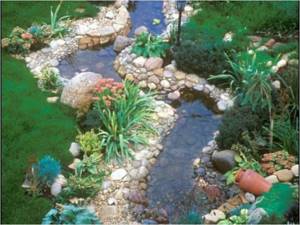
Dry streams are quite popular in China. They are the central elements of rock gardens, a symbol of water and continuous movement. In the East, a landscape is considered incomplete without water or its imitation. A dry stream is an excellent alternative for gardens where it is impossible to build a real pond.
Japanese style stream
Some advantages:
- A dry stream harmonizes with any landscape design.
- Plays the role of a drainage ditch without the need to invest extra time, labor and money.
- Possibility of arrangement on hills and depressions, in the sun or in the shade.
- An artificial dry stream can be made in just a few days.
- There is no need to level the landscape, lower the relief or deepen the riverbed.
- There is no need to purchase a pump and accessories for pumping water.
- Possibility of planting any plants, not just moisture-loving ones.
A dry body of water must have a mouth and a source. As for the mouth, it can be hidden behind the large leaves of hosta, bergenia or other plants, while the source should be on a hill. Make a small depression, lining it with fine gravel. In this simple way you will create a semblance of a well, the illusion of a water source.
Decorative design of a dry stream
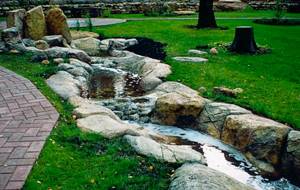
Arranging a stream with pebbles
Sand is perfect for marking the area. So, you can outline the contours of a dry body of water. A man-made stream may consist of several channels or just one. If you want it to look natural, then change its width in different areas.
To prepare the surface, remove the layer of turf and level the ground. You can use a regular garden rake for this. There should be a small depression (10–15 cm). Remember that an excessively concave rivulet looks unnatural.
Decorating a dry stream with boulders
Decorative elements will help you effectively design a dry stream. This could be, for example, a decorative bridge spanning a stream, etc.
Selection of materials
When arranging ponds on your summer cottage with your own hands, you should approach the choice of material with the utmost care. There are many options for what material is best to use to build a small pond in your dacha with your own hands.
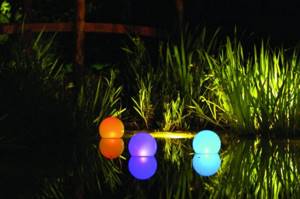
The photos in the article and the list below highlight the following main categories.
Concrete pond
A capital structure, which is the most expensive option for arranging a pond in a country house. The advantages of using this material include increased strength and durability of use.
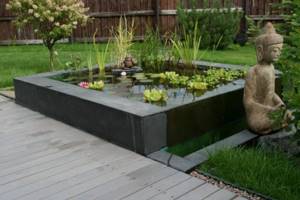
Plastic container
An industrially made mold made of high-strength plastic allows you to solve the question in the shortest possible time: how to make a pond at your dacha with your own hands. Various shapes and sizes allow you to choose an option suitable for the most demanding owner.

PVC film or polyethylene film
The use of these materials makes it possible to create a garden pond with your own hands of absolutely any shape. The disadvantages of such a material include low resistance to external influences and a short service life
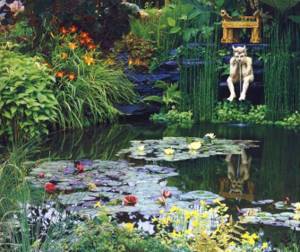
Butyl rubber membrane
A do-it-yourself garden pond made from such a film will please the eye longer than the decorative pond in the photo below made of polyethylene or PVC. When planning how to make a pond on your site with your own hands, it is worth considering that the service life of the membrane reaches 50 years, and the increased resistance of butyl rubber to severe frosts makes it a very advantageous material.

To save money, you can use various available materials. An old bathtub, basin or car tire for a mini pond - these and other “folk” remedies are used to create ponds in the country. Our photo gallery will suggest other original ideas.
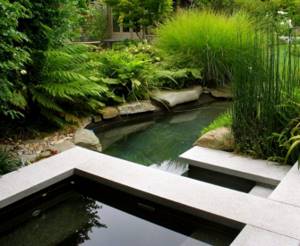
Plot
1 vote
+
Vote for!
—
Vote against!
Despite the fact that water has long attracted people’s attention with its beauty and the alluring power of a powerful element, only a few can boast of having a reservoir in their summer cottage. Today this task is quite feasible, since everyone will be able to create an artificial reservoir, the purpose of which will be very multifaceted, which is determined by the variety of its functions. Due to the rapid development of landscape design and decorative techniques associated with the design of a site, a pond in a dacha has ceased to be positioned only as a cozy corner for relaxation. Currently, experts in the field of landscape design are promoting the need to perceive a decorative pond in a dacha as a significant element of a single whole, the main purpose of which is to visually expand the boundaries of a closed space, as well as eliminate all barriers created by the gray walls of dacha buildings and green hedges. But in order for the pond to become a functional unit of a single whole and harmoniously complement the holistic landscape of the local area, you need to take care of its proper design, after completing which you can confidently say that your pond has become a real decoration of the local area. And, despite the fact that decorating a pond is not an easy and very troublesome task, if you approach it correctly, during which you show a fair amount of imagination, you will be able to recreate a real work of art with your own hands.
Content
- Varieties of pond design: main characteristics
- Stylistic directions in the design of a pond at the dacha
- Sequence of actions when decorating a pond. Rules for choosing terrain
- How to choose the optimal location for a pond?
- How to correctly determine the size of a pond?
- Planting plants as the main way to decorate a pond
- Compositional principles of pond landscaping
- Density of planting in water: deep-water arrangement of a reservoir
- Decorating a pond with stones: increasing the decorative characteristics of the reservoir
Varieties of pond design: main characteristics
Since there are two main types of pond design, it can be implemented in two versions.
A classic or so-called formal pond involves creating a body of water of regular geometric shape, such as square, round, elliptical or L-shaped. This option is considered the most preferable for decorating small garden plots, the landscape of which is also oriented towards the predominance of the classics. Reservoirs of correct geometric shape help to introduce additional symmetry and orderliness into the design of the site. To emphasize the clear lines and right angles of the reservoir, its perimeter is trimmed with tiles made from natural or artificial stone. To play up the theme of classics and clear geometric shapes, experts suggest betting on the arrangement of a raised reservoir, which is significantly elevated from ground level and does not require digging a pit. And to make it more charming, designers recommend installing a fountain near the pond.

A free-form pond will become an original addition to your garden if it is arranged in a landscape style, which is characterized by more natural outlines. Subsequently, having become a “full” part of a single whole, such a pond will be able to function as an independent ecosystem, which is characterized by its own principles of self-regulation and self-purification. But this is only possible if the pond itself is characterized by impressive dimensions and an area of at least 5 square meters. meters. Due to the characteristics of the pond as an independent ecosystem, this reservoir is designed for long-term operation and does not require careful maintenance. The free outline of a decorative pond placed in a landscape garden opens up great opportunities for the designer regarding its design. As for the features of landscaping such a pond, its main concept is aimed at giving the pond the most natural, natural outlines possible. In addition, the plants occupying the coastal zone of the pond must compositionally connect it with a single landscape, making it an integral part of a single whole.

Decoration of a pond photo
Stylistic directions in the design of a pond at the dacha
Oriental motifs in pond design are far from uncommon. This is due to the fact that traditionally the decorative design of reservoirs originated in the hot countries of the alluring East, where water was a real luxury. The precious liquid, constantly shimmering on the site, is the prerogative of only rich people, who preferred to place decorative fountains near artificial reservoirs, adhering to the principles of regularity and strict geometric shapes when designing them.
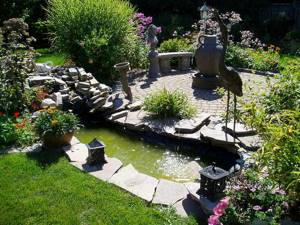
Chinese style , a notable feature of which is a large amount of lush vegetation, which corresponds to the maximum extent to the principles of the landscape direction. A pond decorated in Chinese style is characterized by the following features:
- Water surface with an impressive area;
- Curvature, sometimes ornate lines and smooth forms, which fully emphasizes the natural origin of the reservoir;
- In the center of the water composition, as a rule, there is an island that has no connection with the coastal part of the pond;
- On this island there may be a massive stone, a lonely growing tree or shrub;
- A bridge is often installed across the pond, connecting the coastal zone with not too distant areas of the pond. Not a rare addition to the bridge is a lantern of exquisite shapes and outlines, which will add special romance to the pond at night;
The Japanese style in the design of a pond is distinguished by the constant presence of asceticism of all forms and lines, striking and at the same time attracting the gaze of an uninitiated person. The rigor of the composition must be emphasized by the geometric shape of the pond, which can be either square or rectangular. An important addition to a Japanese-style composition is the presence of a carefully thought-out sequence of boulders and stone blocks that will inevitably attract the gaze of the beholder. As a rule, dwarf shrubs and trees are planted along the coastal line of the pond.
French style is a trend that has become widespread in European countries. In most cases, the French style is used as the basis for modern movements such as Art Nouveau and Futurism. French artificial ponds have the following features:
- The impressive size of the landscape elements, including the pond;
- Absolutely clear geometric shapes of the pond, which must be emphasized using tiles made of natural or artificial stone;
- An important distinctive feature of the pond is a certain elevation of the pond’s height line compared to the coastal zone.

Sequence of actions when decorating a pond. Rules for choosing terrain
If you are planning to create a pond on your summer cottage and subsequently properly design it, follow our proposed algorithm for designing and decorating a pond.
- Development of a project for an artificial reservoir on the site;
- Selecting the most suitable territory;
- Drawing up a dendroplane and selecting the necessary plants for landscaping the pond;
- Selection of stones in accordance with the previously compiled composition;
- Carrying out measures to decorate the pond;
- And a selection of fish that you can refuse.
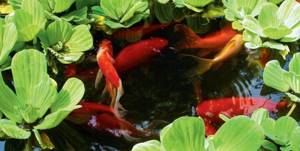
How to choose the optimal location for a pond?
There are a number of recommendations that must be followed when selecting a site for a pond. Before you start choosing a location, familiarize yourself with them in order to avoid the most common mistakes in the future.
- Experts recommend giving preference to open areas and deliberately avoiding areas located in the thick of spreading trees. Subsequently, this will prevent contamination of the pond by fallen leaves, as well as the destruction of its banks by the overgrown root system of trees;
- To subsequently prevent difficulties with expanding the landscape area of the pond and further improving its attractiveness, demarcate an area whose size is significantly larger than the expected size of the artificial pond;
- Avoid placing the pond in sunny areas, which will prevent excessive heating of the water surface and, accordingly, the proliferation of bacterial flora and “blooming” of water. In addition, this will protect plants from premature rotting and wilting caused by the creation of an unfavorable environment for their life;
- It is advisable to give preference to a windproof area, more or less protected from the winds, which will help protect graceful aquatic and coastal plants from damage, and also prevent premature clogging of the pond associated with the continuous transfer of dust and soil particles, as well as leaves and weed seeds . The accumulation of these particles on the surface of the water surface leads to pollution of the pond ecosystem;
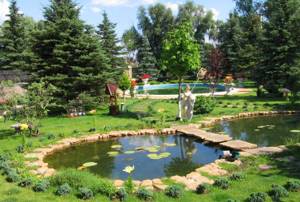
How to correctly determine the size of a pond?
Despite the fact that the choice of pond size largely depends on your preferences, you still need to follow the basic rules for its design, according to which the total size of the pond is no more than 3-4% of the total area of the site;
- If you are planning to arrange a single pond on your site, decorated only with vegetation, the most preferable would be to arrange a pond measuring 3x3 or 2x2 meters, the depth of which will not exceed 50-70 cm;
- If you plan to add fish to a pond, take care to increase its depth in order to provide the fish with the most favorable wintering conditions in a limited space;
- If the adjacent gardening and park area is located on a plot of impressive size and is characterized by a variety of decorative elements, it is recommended to equip the plot with a pond of a slightly larger size than provided by the standards;
Planting plants as the main way to decorate a pond
Despite the fact that you seem to have completely equipped your garden pond, it will only acquire a finished appearance after landscaping. The first impression a pond makes on the viewer is largely determined by the design of its shoreline. However, if you show imagination and patiently approach the landscaping of the pond, with the help of green spaces, even the most ordinary body of water can be turned into a real masterpiece.
Compositional principles of pond landscaping
When developing a pond design and drawing up a dendroplan, follow a number of recommendations that will allow you to rationally design the pond with your own hands.
- On the northern shore of the pond, it is recommended to densely plant taller trees and shrubs, as well as tall herbaceous vegetation, in contrast to the southern shore, where only low-growing plant crops are placed. This method of planting vegetation will ensure rational heating of the reservoir. Depending on the prevailing direction of the winds, for the same purpose, tall vegetation is planted on the western or eastern shore, which should still be less common than on the northern;
- In accordance with the following compositional technique, it is necessary to correctly place visibility points (places of the best view of the coastal area), thanks to which you can visually bring the surface of the water closer, while simultaneously increasing its area. For example, if you designate a visibility point in the direction perpendicular to the longest axis of the pond, and on the side of the pond opposite from the visibility point, plant blue plants (irises, forget-me-nots, speedwell), you can recreate the illusion of perspective, visually increasing the surface of the water surface;

Before you start planting, it is important to remember that the pond is divided into several functional zones:
- Water surface area;
- Deep and shallow water zones;
- Coastline area.
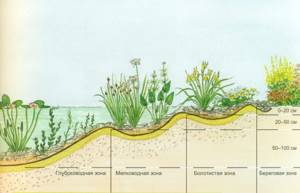
In accordance with the designated zones, all plants that are appropriate for decorating a pond can be divided into several groups:
Surface plants , the life of which does not require soil, since they float on the surface of the reservoir. The maintenance of their vital functions is determined by the required concentration of substances in the reservoir. This group includes:
- Water hyacinth;
- Azolla;
- Wolfia;
- Duckweed;
- Hydrocleis;
- Water chestnut;
- Watercolor.
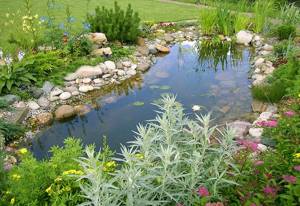
Deep-sea plants , for the normal functioning of which, the height of the pond must be at least 50 cm. For greater convenience, experts suggest placing deep-sea plants in containers installed in the depths of the reservoir. Among the deep-sea plants there are:
- Water lily,
- Capsule;
- Nymphaeum;
- Orontium;
- Mulberry.
Plants-oxygenators , that is, plants that contribute to the natural purification of water, should be an indispensable component of the reservoir. For their normal functioning, carbon dioxide is necessary, by absorbing which oxygen-generating plants will release saturated oxygen. Despite the fact that they do not require maintenance, they will prevent the pond from becoming overgrown with mud and will significantly facilitate the process of caring for it. In addition to their practical significance, one cannot help but note their remarkable appearance and extraordinary shape. The most interesting among them are:
- Hornwort;
- Erodea;
- Urut.
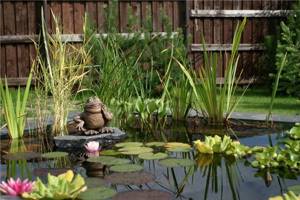
Coastal plants for a garden pond are another integral variety of plants for decorating a pond, which will allow you to organize a smooth transition from one landscape element to another. Among coastal plants for decorating the banks of a pond, it is necessary to note species whose favorable environment for growth is moist soil. For example:
- Swampman;
- Narcenium;
- Rider;
- Sedge;
- Sitnik;
- Whitewing.
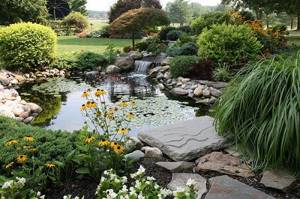
When designing the shores of a pond, it is necessary to take into account that the shore is divided into two functional zones: wet and dry. The latter is represented by traditional ground flora, which will combine the pond with the entire landscape. For example, near a pond, willow or pine trees will fit well into the overall composition, thanks to which it will be possible to recreate a forest lake or spring.
Shallow water or wet line must be planted with plants that thrive in moist soil. Due to their high adaptive abilities, these plants can successfully tolerate both waterlogging and drought. These include iris, calamus, arrowhead and reed.

Density of planting in water: deep-water arrangement of a reservoir
Planting in a pond is somewhat similar to planting in a garden, and it also involves spacing the plants out as they tend to grow. According to professionals, a third of the pond should not be planted at all, but this also depends on the type of planting material.

Deep water plants, also called floating leaf plants, grow at the bottom of the pond while their leaves are located on the surface. Since they require bottom substrate and soil, they are preferably cultivated in containers installed at the bottom of the reservoir. Before you start planting plants, you need to decide on the density of their arrangement, which will prevent premature overgrowing of the pond. To optimally navigate the planting density, follow these recommendations:
Along the banks of the pond, as well as in the wet area, plant no more than 3-4 small plants per 1 square meter. meter (for example, arrowhead, marigold or buttercups), or 2-3 larger plants per 1 sq. meter (cattail, bergenia, iris).
The shallow water zone, the depth of which does not exceed 15 meters, is planted based on the rule: 2-3 plants per 1 square meter. meter.
Plants-oxygenators and deep-sea species are planted no more than 1-2 pieces per 1 square meter. meter.
Decorating a pond with stones: increasing the decorative characteristics of the reservoir
An obligatory element of the landscape of any man-made reservoir are stones of various types and shapes. They can be completely or partially covered with water, which creates a unique effect of naturalness and at the same time decorativeness. It is important to remember that every stone must be in its place. For example, a shallow coastal zone can be decorated with large boulders covered with massive caps of moss, partially submerged in water, while small pebbles will be in their place if placed on the bottom of a reservoir. When decorating a dry coastal zone, you can use the largest specimens.
Important! Stones with a calcareous structure are not recommended for use, as they lead to an increase in pH in the reservoir, which contributes to an excessive increase in the growth of aquatic vegetation.
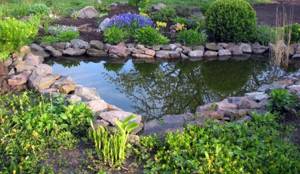
The main types of stone for pond design are:
- Marble;
- Granite;
- Gneiss;
- Sandstone;
- Quartzite.
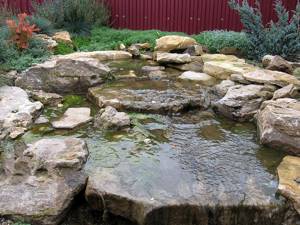
The use of a specific species when decorating a pond with stones depends on the landscape direction you choose. It could be a couple of massive acute-angled blocks, a scattering of small pebbles, or massive marble boulders along the shore of the pond. Despite the very democratic approach to choosing stones for decorating a pond, it is important to avoid excessive variety so as not to create the impression that the pond was created artificially.
Designers also offer a more modern approach to decorating a pond with stones, involving the use of artificial stones, such as ceramic slabs and colored concrete. However, it is important to remember that when choosing this decoration option, there can be no question of any naturalness of the reservoir.
Necessary equipment
Depending on the functionality of the reservoir and the material from which it will be made, the following tools may be required during the creation process: a shovel, a cart for transporting excess soil, a level, pegs and a strong cord for marking, as well as a hose for watering. This set of tools will be enough to place mini ponds in your dacha with your own hands, as in the photo above. If the planned pond in the garden is of significant size, it is worth assessing the feasibility of using construction equipment. For a pond intended for fish breeding or designed for a particularly long service life, the installation of additional equipment may be justified:
- An aerator that saturates the water with oxygen necessary for fish.
- Pump for filling or draining water.
- Cleaning filter.
- A device for sterilizing water and removing dead algae.
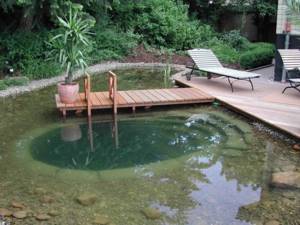
Details of creating a pond from film
PVC film, due to its performance qualities and relatively low cost, is one of the most popular materials for pond construction. In addition, in order to make a pond with your own hands from PVC film, no special skills or special knowledge are required.
To equip reservoirs, you should not use films with a thickness of less than 0.5 mm, and if you plan to create a particularly deep reservoir, it is better to take a film with the maximum available thickness.
The use of multi-colored film allows you to achieve different optical effects: black will make the bottom of the reservoir mirror-like, and nearby trees and buildings will be clearly reflected in it, brown film is perfect for simulating the soil bottom, and film of light blue or cream tones will make the reservoir as transparent as possible, which will allow you to conveniently observe the movement of fish.
The selected film should be cut so that it covers the bottom and walls of the reservoir, leaving a margin of up to one meter. The cut pieces must be joined with specialized glue or adhesive tape for such work.
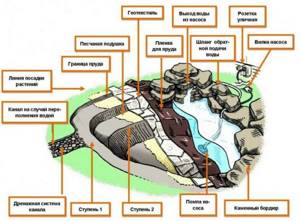
Before digging a pit, you need to carefully consider the size, shape of the bottom and walls of the reservoir. If you plan to create a complex multi-stage structure, it is better to first draw a detailed diagram on a sheet of paper indicating all dimensions.
Having marked the selected area, we begin to dig a hole. It is better to remove soil in the direction from the edges of the future reservoir to the center, gradually going deeper to the required limits. The bottom and walls of the finished pit must be carefully examined for the detection of foreign objects, sharp roots, etc. Any debris found must be removed to prevent damage to the film. We lay the prepared film on the compacted bottom of the pits, fixing it with stones and sprinkling the edges with soil.
Next, you need to strengthen the banks of the pond. For this you can use various materials. For flat banks, a geogrid or polymer grid is suitable; you can also use a regular chain-link mesh. For vertical banks, the use of piles or supports will be required.
You can complete the design of the pond by adding various decorative elements, planting plants and installing underwater or outdoor lighting.

How to make a stream in the country? Main stages
First, let's decide what type of stream you want to create. The classic is running water that intricately meanders and crosses the entire site, going underground. However, it is worth considering that the stream can be of natural origin, and it can flow in a straight line. When you create an artificial stream, you yourself set the trajectory of the water flow. In this case, in order for the water to move, you will have to connect a pump. However, it should not be visible.
A simpler option is a dry stream where there is no water. This is a kind of stylized landscape element that just imitates running water. Now let's take a closer look at each option.
If there is a natural stream on the site, it usually does not present a very attractive sight: overgrown, with a swampy smell due to the low speed of water flow, which can sometimes even stagnate. First you need to examine it, see where the narrowest and widest places are.
Then you need to remove the weeds along the banks. Armed with a shovel, you can give the stream several bends and widen it in narrow places. By filling and deepening, try to increase its slope to give greater speed to the water. However, be careful with this.
If the banks are very steep, try to make them flat and, if possible, slightly level the area near the stream by 2 meters in both directions. The stream should not resemble a ditch.
It is also necessary to clean the bottom of debris, and then lay pebbles and stones on it in random order, of different sizes. This will allow the stream to gurgle happily. You also need to put stones on the shore, burying them 1/3-1/2 into the ground.
The next stage is planting the plants. Moreover, try to select low-growing species, plant not densely, otherwise the stream will be lost behind lush vegetation.
Now let's look at creating an artificial stream. We take a plan of the site and plot its trajectory. It is very good if the terrain has a slope, because on a flat area you will have to form it by filling, and this is an extra cost. However, don’t worry, water can also run on almost flat terrain with a minimal slope, pumped by a pump.

Then we begin to remove the stream into nature. It is necessary to dig a shallow groove (about 20 cm) with gentle banks. With a slope of 3 cm per 1 m, the flow of water will already be visible to the naked eye. It will also not be bad if you make one or more drops that will act as mini-waterfalls.
The bottom is compacted, and a special film is laid on it, which does not allow water to pass through. Make sure that there are no sharp stones, roots or other inclusions at the bottom that could tear the material. It is advisable to pour sand under the film in a layer of 5-6 cm (tamp).
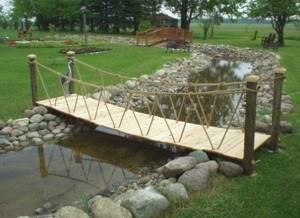
Instead of film, you can make a channel of concrete. While the concrete has not hardened, stones and pebbles are inserted into it. The disadvantage of this design is the need for shelter for the winter. Also, if all the water is not removed and it freezes, the bottom of the stream bed will become covered with cracks through which water will leak out in the summer.
If the slope of the bottom does not allow creating drops, then they can be made using large flat stones, which are laid at a slight slope in the direction opposite to the flow of water.

The stream will flow into a container (for example, an old bathtub) buried in the ground. On top it can be covered with a fine metal mesh, on which pebbles and stones are laid out (disguised). A pump is installed in the container, which will supply water through a hose to the source. The hose is buried in the ground.
To create a dry stream, you can use the technology discussed above, only without water. You can read more details here.
Decoration with plants
When decorating a pond in the garden with plants, you should understand that they are divided into those that are planted on the shore along the edges of the pond, and plants that live directly in the water. The root system of shore plants will additionally strengthen the walls of the pond. When planting plants in a pond in the garden, it is important to keep in mind the speed of their growth, otherwise, after a long absence, there is a risk of finding a pond completely covered with a thick carpet of vegetation.
Wrong size
. A small puddle located somewhere near the fence or at the entrance to the garden and sandwiched on all sides by lush and beautiful garden plants, no matter how hard you try, will always look miserable.
The size of the reservoir must be correlated with the surrounding space

But this does not mean at all that a small body of water (for example, in the form of a spring) cannot decorate the garden at all. Simply by choosing this or that image, you need to correlate it with the surrounding space. If you don’t have room in your garden for a large pond, perhaps a selection of miniature ponds: a dozen simple ideas will help you find a solution. A successful example is also presented in the publication Saucer of Water as the completion of a dry stream.
Decor
In order to decorate a pond in the yard with your own hands, in addition to various plants, beautiful stones and other decorative elements, the use of lighting gives a good effect. The colored glow spreading from under the water will create a wonderful decoration for your pond at night. Additional lighting can also be placed above the water.

You can use various fountains as decor for decorating a pond at your dacha with your own hands, as in the photo in the article. The functioning of the fountains is ensured by the operation of pumps, which can be hidden at the bottom of the pond under the stones. Surface devices are also used. Pumps come in different capacities, which affects the height and intensity of the water jets.
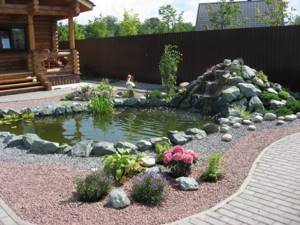
Landscape design options for a garden with a pond
After choosing a suitable location, you should decide how to design the pond. There are many options. Landscape design offers a wide selection of different decorative solutions.
One option is to install a decorative fountain. You can make it yourself or buy it ready-made. If you have additional space, you can complement the composition with a bridge and garden figurines.
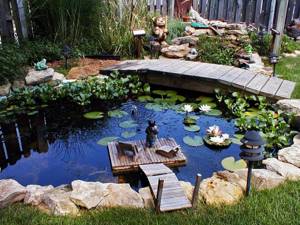
It does not require much space, and with its help you can zone an area and highlight certain objects.
Plants are often used for decoration. They are divided into shallow and deep water. To plant the latter, special baskets placed at the bottom of the pond are used.
Important! Deep-water plants should occupy a maximum of 30% of the total water area. Otherwise, visually the reservoir will look like a swamp.
Plants must be planted carefully, given that over time they will become larger and more luxuriant.
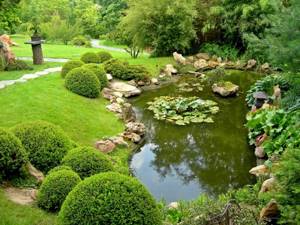
Don’t plant it with plants: let the surface of the water reflect the sky, visually increasing the size of the pond.
You can plant nymphs. And only after that proceed to placing the decorative stone at the bottom. In the terrace area it is recommended to plant sedge, susak, and marsh whitewing. For water surfaces, swampweed, hyacinth or bagel are suitable.
Away from housing, place free-form ponds close to their natural surroundings.
Fountains and streams create the effect that water is moving in a natural stream. A stream can be run through the entire garden using the same materials as when constructing a reservoir.
If the pond is small and narrow, you should not plant tall plants close to it. They will grow and completely cover it.
Not only the structure itself needs to be decorated, but also the area around it. A decorative stone is suitable for the path. Tiles of different sizes will allow you to create an original ensemble. Additionally, spotlights or small lanterns can be installed around the perimeter. In the evening, soft light will create a magical atmosphere.

Even a small pond made with your own hands can be supplemented with the attributes of a large one: a stream or waterfall flowing into it.
The design of a swimming pond should begin with the arrangement of the adjacent area. It can be given the look of a sunny beach. It is enough to scatter sand nearby, place a table, an umbrella and sun loungers.
This design of the pond on the site will create a beach atmosphere.
Pond care
A decorative pond at the dacha requires some care. Planted plants must be protected from the cold or moved to a warm room. During a long absence, the surface of an artificial reservoir at the dacha should be covered with a special mesh to protect it from debris. Leaves and other debris that have fallen into the country pond are caught with a net, and if a large amount of sludge forms, it is necessary to clean the reservoir. The water must be periodically updated using a garden hose or a regular bucket (if specialized equipment is not available).
Floating plants for a pond in the country
Landscaping a pond is done for two reasons: decoration and maintaining biological balance. Without vegetation, the water will stagnate, acquire a bad odor, and become covered with mud. If there is a fish in the pond, then it will not be able to live without plants, but various microorganisms, such as bacteria, will be able to develop. Therefore, first of all, you need to take care of the presence of plants that purify the water.
Oxygen generating plants release oxygen into the water by absorbing carbon dioxide, thus preventing pond pollution. They live in the water column and do not have a root system as such, and use the existing roots as an anchor. These include: bogwort (water star), turcha (water feather), urut, hornwort, elodea, etc.
In order to plant oxygen generators, it does not take much time: just immerse the plant in the water column. These underwater inhabitants are also unpretentious in care, they are cold-resistant and are ready to grow in the shade and in the sun. Their quantity is easy to regulate by removing excess greenery with a net. If the pond is not drained during the winter and does not freeze to the very bottom, then these plants will be able to successfully overwinter in the pond.
In addition to oxygen generators, plants floating on the surface live in the water column. These representatives of the flora do not need soil, but feed by absorbing nutrients from the water. In turn, they contribute to the filtration of water in the pond. Such plants are water chestnut, azolla, watercolor, wolfia, pistia, duckweed, water hyacinth, etc.
When choosing a floating plant for a pond at your dacha, you should take into account that many of them do not like low temperatures. Pistia and hyacinth will not bloom in cold summers and may even die. For the winter they should be placed in a warm aquarium. Duckweed and azolla grow extremely quickly, which requires constant monitoring of their quantity, otherwise they will cover the surface of the entire reservoir. Watercolor overwinters at the bottom of the reservoir and feels good in the shade, growing very slowly.
Photo gallery
In our photo gallery you will see more than 33 examples of beautiful ponds in the country.


